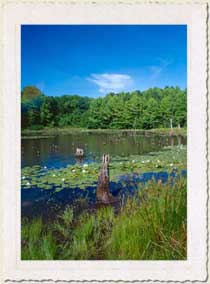
Blue Heron Park Preserve
Borough: Staten Island
Acres: 169
Habitat Type: Forest, Grassland, Shrubland, Freshwater Wetland
Map: PDF
Blue Heron Park is named after the gray-feathered predatory bird with a yellow bill, the great blue heron (Ardea herodias), which can be found throughout much of the New York area. Reaching more than four feet in height, it can typically be spotted standing at the edge of a pond or marsh, watching for fish or frogs. These animals make up their main diet, though they will also eat small mammals, reptiles, and smaller birds on occasion. Most herons migrate south in the fall, and those that remain in the north often fall victim to severe weather.
The City acquired this parkland in several segments between 1974 and 2001. By the time of its official dedication on October 22, 1996, a handful of concerned Staten Islanders had been working to preserve and protect the land for a full 33 years. Over time, their efforts were rewarded with the interest and hard work of many of their fellow residents and many Parks officials. Blue Heron Park has become an outstanding wildlife sanctuary and educational resource. The years have seen it transformed from a wasteland filled with over 30 abandoned cars to a peaceful refuge of walking trails, meadows, ponds, streams, and woodlands. Visitors walking along any of the three main trails of the park will find an impressive array of wildflowers, including Wild columbine (Aquilegia canadensis), Black-eyed Susan (Redbeckia hirta) and Jack-in-the-pulpit (Arisaema triphyllum).
The park also holds six ponds, among them the 1.75-acre Spring Pond and the 1.4-acre Blue Heron Pond, crossed by a popular footbridge. These kettle ponds were formed 15,000 years ago by the retreating Wisconsin glacier. Today they are teeming with marine life such as the curve-billed glossy ibis (Plegadis falcinellus), the black-crowned night heron (Nycticorax nycticorax), wood duck (Aix sponsa), owls (Strigiformes), osprey (Pandion haliaetus), turtles (Chelonia), and white water lilies (Nymphaea odorata). Spring peepers (Pseudacris crucifer) and tree frogs (Hylidae) find ample breeding grounds in the ponds, where nature enthusiasts flock to observe the thriving ecosystem.
Photographs
Directions
Public Transit: From ferry, take the S78 bus along Hylan Boulevard to Poillon Avenue. Take a right on Poillon and walk 1/5 of a mile to the park entrance and Nature Center.
Take S.I.R.T. to the Eltingville Station. Transfer there for the S79 or S59 bus to Poillon Avenue and walk 1/5 mile to park entrance and Nature Center.
Take the S.I.R.T to the Annadale station and walk six blocks toward Amboy road. Take a right onto Poillon Avenue and walk 1/5 of a mile to park entrance and Nature Center.
By Car: Take the Verrazano Bridge to the S.I. Expressway (Route 278) to Hylan Boulevard exit. Take a right on Poillon Avenue and proceed 1/5 mile to park entrance and parking lot on your left.
OR Take the S.I. Expressway to West Shore Expressway (towards NJ outer Bridge). Exit at Huguenot Avenue and make a left onto Huguenot Avenue. Stay right at split in road. Proceed on Huguenot and take a left on Amboy Road. Take a right on Poillon Avenue and proceed to park entrance and parking lot on your right.

